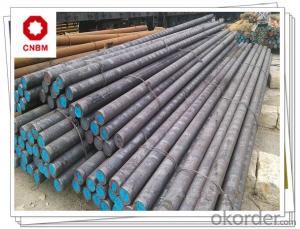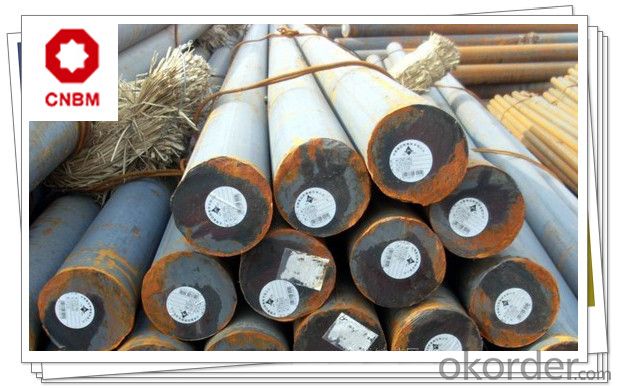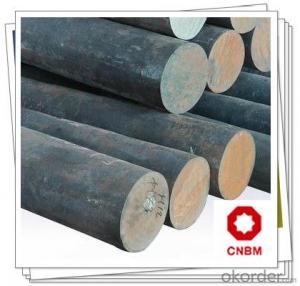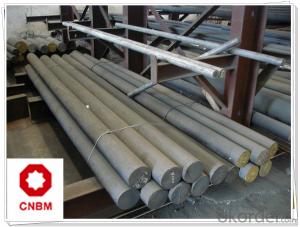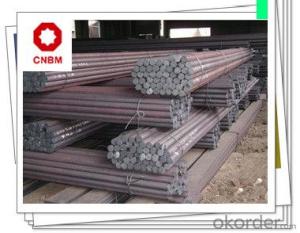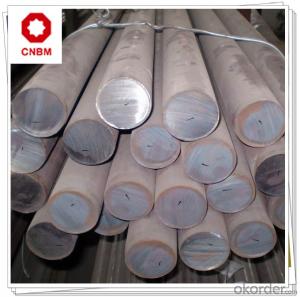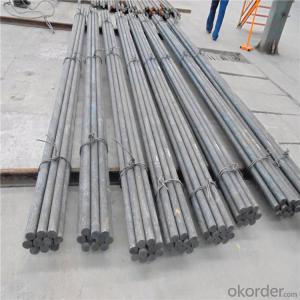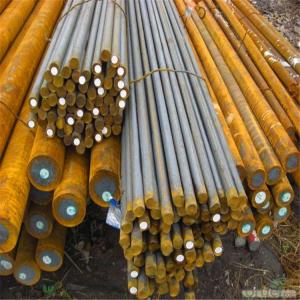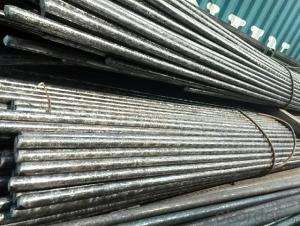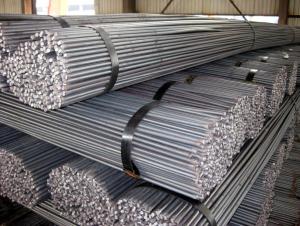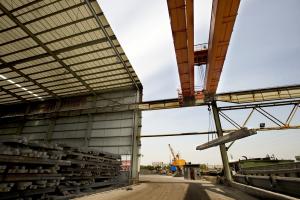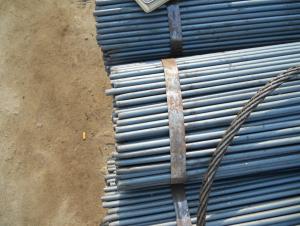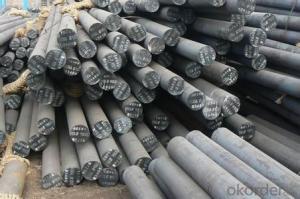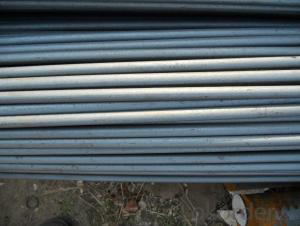Hot Rolled Carbon Steel Round Bars S30C
- Loading Port:
- Shanghai
- Payment Terms:
- TT OR LC
- Min Order Qty:
- 50 m.t.
- Supply Capability:
- 120000 m.t./month
OKorder Service Pledge
OKorder Financial Service
You Might Also Like
Hot Rolled Carbon Steel Round Bars S30C
Product Specification
1, Chemical Composition %
| Grade | C | Si | Mn | S | P | Cr | Ni | Cu |
| S30C | 0.27-0.34 | 0.17-0.37 | 0.50-0.80 | ≤0.035 | ≤0.035 | ≤0.25 | ≤0.30 | ≤0.25 |
2, Diameter: 16mm - 300mm
Length: Max 12m
Application
1, Used as mending of drawing parts of automobile sheet metal die and large hard ware sheet metal die.
2, Used as base plate of cold working die.
3, Used as fix plate of drill jig.
Product Main Points
1, Heat Treatment: normalizing, annealing, tempering, quenching
2, Surface Treatment: black, grinding, bright, polish
3, Product Process: hot rolled, cold drawn, forged
FAQ
1, Payment Terms:
30% T/T deposit & 70% T/T before delivery.
Irrevocable L/C at sight
2, Trade Terms:
EXW, FOB, CIF, CNF
3, Delivery Time:
Normally 30-40 days. According to quantity.
4, Manufacture or Trading Company:
CNBM is a state-owned fortune global 500 trading company. We have intergrated supply system.
There are about 20 overseas locations in different countries.
Product Show
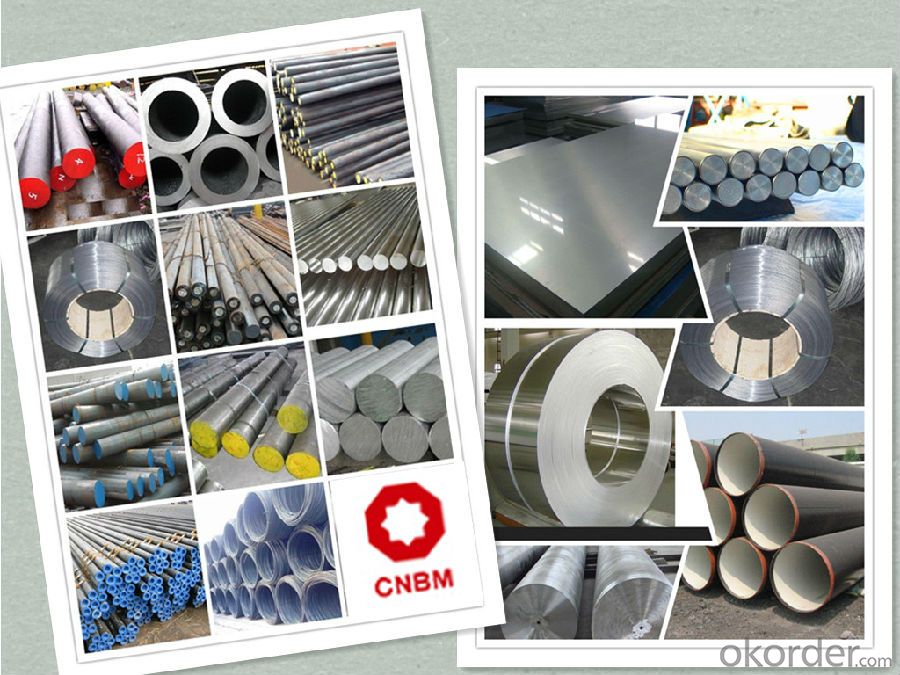
Work Shop
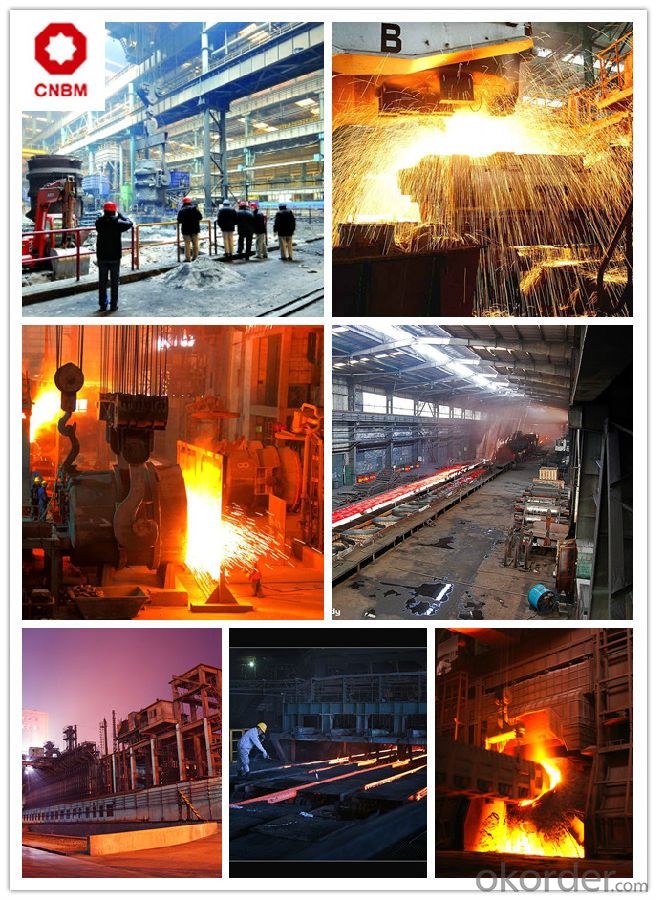
About Us


- Q: What is the difference between hot rolled and cold drawn steel round bars?
- Hot rolled steel round bars are made by heating a billet or ingot of steel to a high temperature and then rolling it into the desired shape. This process results in a rougher surface finish and less precise dimensions compared to cold drawn steel round bars. Cold drawn steel round bars, on the other hand, are made by pulling a hot rolled bar through a die to achieve the desired shape and size. This process produces a smoother surface finish and more accurate dimensions. Overall, the main difference between hot rolled and cold drawn steel round bars lies in the manufacturing process and the resulting surface finish and dimensional accuracy.
- Q: Can steel round bars be used for shafting applications?
- Yes, steel round bars can be used for shafting applications. Steel round bars are commonly used as shafting material in various industries such as automotive, construction, and manufacturing. They offer high strength, durability, and excellent mechanical properties, making them suitable for transmitting power and rotational motion in machines and equipment. Steel round bars can be machined to precise dimensions, heat-treated for increased hardness, and coated to provide corrosion resistance. Additionally, they are available in different grades and alloys to meet specific application requirements. Overall, steel round bars are a reliable choice for shafting applications due to their inherent strength and versatility.
- Q: How do you calculate the deflection of a steel round bar?
- To calculate the deflection of a steel round bar, you need to consider various factors such as the bar's length, diameter, and the applied load. The deflection of a bar refers to the amount it bends or flexes under a specific load. The deflection can be determined using the formula for beam deflection, which is derived from Euler-Bernoulli beam theory. The formula is as follows: δ = (F * L^3) / (48 * E * I) Where: - δ represents deflection - F is the applied load - L is the length of the bar - E is the modulus of elasticity of the steel material - I is the moment of inertia of the round bar To calculate the moment of inertia (I) for a round bar, you can use the formula: I = (π * D^4) / 64 Where: - I is the moment of inertia - D is the diameter of the round bar By substituting the values into the formula, you can calculate the deflection of the steel round bar under the given load. It is important to note that these calculations assume the bar is perfectly elastic and obeys the principles of linear elasticity.
- Q: How do you calculate the weight of a steel round bar based on its length and diameter?
- To calculate the weight of a steel round bar based on its length and diameter, you can use the following equation: Weight = (π/4) x (Diameter^2) x Length x Density Here, π represents the mathematical constant pi (approximately 3.14159), Diameter is the measurement of the steel round bar across its widest point, Length is the overall length of the bar, and Density is the density of steel, which is typically around 7850 kilograms per cubic meter. To calculate the weight, first square the diameter, then multiply it by the length and density. Finally, multiply the result by π/4 to obtain the weight of the steel round bar in the desired units (typically kilograms or pounds). It's important to note that this equation assumes the steel round bar is a solid cylinder with a uniform diameter. If the bar has any variations or irregularities, the weight calculated using this equation may not be entirely accurate.
- Q: What is the maximum elongation of steel round bars?
- The maximum elongation of steel round bars depends on various factors such as the type of steel, its composition, and the manufacturing process. However, in general, steel round bars can have elongation values ranging from 10% to 30% before they reach their maximum limit and start to deform permanently.
- Q: What are the environmental benefits of using steel round bars?
- There are several environmental benefits of using steel round bars. Firstly, steel is a highly recyclable material, which means that using steel round bars can help reduce the demand for new raw materials and decrease the amount of waste sent to landfills. Additionally, steel production processes have significantly improved in recent years, resulting in lower emissions of greenhouse gases and air pollutants. Steel is also durable and long-lasting, reducing the need for frequent replacements and saving valuable resources. Overall, the use of steel round bars can contribute to a more sustainable and eco-friendly construction industry.
- Q: What are the different packaging options for steel round bars?
- Customers have various packaging options to choose from when it comes to steel round bars, depending on their specific needs and requirements. Some commonly used packaging options include: 1. Bundles: Steel round bars can be bundled together using steel straps or wire to create a compact and secure package. The bundles come in different sizes, ranging from 2 to 5 tons, and are suitable for transportation and storage purposes. 2. Wooden Crates: For enhanced protection during transportation, steel round bars can be packed in wooden crates. These crates are designed to withstand the weight and size of the bars, ensuring safe delivery to the customer. 3. Steel Cages: In certain situations, steel round bars are packaged in steel cages or racks to provide additional stability and security during transportation. These cages are typically made of sturdy steel and can be stacked, making them suitable for storage as well. 4. Plastic Wrapping: To safeguard the steel round bars from moisture, dust, and other contaminants, they can be wrapped in plastic or shrink wrap. This packaging option is commonly used when the bars are stored or transported in open-air environments. 5. Customized Packaging: Depending on the customer's specific requirements, steel round bars can be packaged in custom-designed containers or crates. These can be tailored to accommodate different sizes, weights, and quantities of bars, ensuring maximum convenience and safety during handling and transportation. It is important to note that the choice of packaging option may vary based on factors such as the destination, mode of transportation, and specific industry standards. Therefore, customers are advised to consult their suppliers or packaging experts to determine the most suitable packaging option for their steel round bars.
- Q: How do steel round bars compare to copper round bars?
- Steel round bars and copper round bars have several key differences. Firstly, steel is a much stronger and more durable material compared to copper. Steel round bars can withstand higher levels of stress and are often used in heavy-duty applications requiring great strength, such as construction and engineering projects. On the other hand, copper round bars are softer and more malleable, making them ideal for electrical and plumbing applications. Additionally, steel round bars have better corrosion resistance than copper round bars. Steel can be coated or treated to prevent rust and corrosion, while copper is prone to oxidation and requires regular maintenance to prevent tarnishing. In terms of cost, steel round bars are generally less expensive than copper round bars. The availability and abundance of steel contribute to its lower price, while copper is a more scarce and costly material. Ultimately, the choice between steel and copper round bars depends on the specific application and requirements.
- Q: What are the advantages of using free-cutting steel round bars?
- There are several advantages to using free-cutting steel round bars. Firstly, they offer improved machinability, which means they can be easily and efficiently machined into various shapes and sizes without excessive tool wear or power consumption. This leads to increased productivity and reduced manufacturing costs. Additionally, free-cutting steel round bars have excellent chip formation properties, resulting in better surface finish and dimensional accuracy of the machined parts. They also exhibit enhanced surface hardness and wear resistance, making them suitable for applications that require durability and strength. Lastly, these bars are readily available and cost-effective, making them a preferred choice for many industries.
- Q: What are the different testing methods for steel round bars?
- Steel round bars undergo various testing methods to assess their quality and performance. These methods encompass: 1. Tensile Testing: This method determines the strength and elasticity of steel round bars by subjecting them to force until they fracture. It measures the maximum load the bars can endure, helping ascertain their ultimate tensile strength, yield strength, and elongation. 2. Hardness Testing: To evaluate the resistance of steel round bars against indentation or scratching, hardness testing is employed. It includes tests like Rockwell, Brinell, and Vickers, which provide insights into the material's ability to withstand wear, deformation, and surface damage. 3. Charpy Impact Testing: This testing measures the toughness and resistance to brittle fracture in steel round bars. It involves striking notched samples with a pendulum and measuring the energy absorbed during fracture. This test is vital in assessing the material's behavior under sudden impact or dynamic loading scenarios. 4. Ultrasonic Testing: High-frequency sound waves are utilized in this non-destructive testing method to detect internal flaws or defects in steel round bars. It identifies cracks, inclusions, or voids that might compromise the material's structural integrity. 5. Magnetic Particle Inspection: This method identifies surface cracks or defects in steel round bars by magnetizing the material and applying iron particles or magnetic ink. Any cracks or flaws cause a leakage of magnetic flux, making them visible under suitable lighting conditions. 6. Visual Inspection: This basic yet essential method involves visually examining the surface of steel round bars for any visible defects such as pits, scratches, or irregularities in shape or dimensions. 7. Chemical Analysis: By analyzing the composition of steel round bars and measuring the percentage of various elements present, chemical analysis ensures that the material meets required specifications and is suitable for its intended application. In summary, a combination of these testing methods is employed across industries like construction, manufacturing, and engineering to guarantee the quality, performance, and reliability of steel round bars.
Send your message to us
Hot Rolled Carbon Steel Round Bars S30C
- Loading Port:
- Shanghai
- Payment Terms:
- TT OR LC
- Min Order Qty:
- 50 m.t.
- Supply Capability:
- 120000 m.t./month
OKorder Service Pledge
OKorder Financial Service
Similar products
Hot products
Hot Searches
Related keywords
